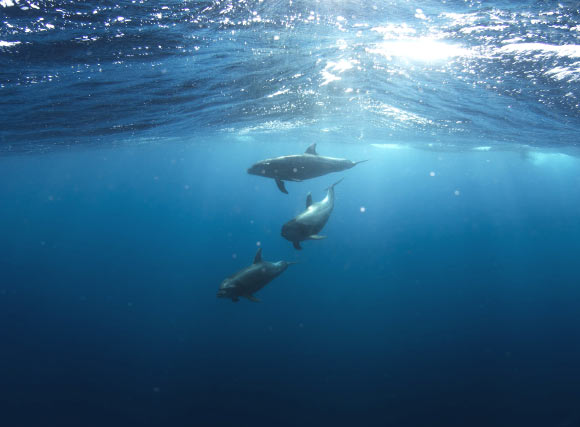In a new study published in the journal PLoS ONE, a team of U.S. researchers examined the diets of three different dolphin species (the common bottlenose dolphin, the melon-headed whale, and the Gray’s spinner dolphin), and also looked at how they divide ocean resources and space.
“We used the principle of ‘you are what you eat’ to unlock some of the secrets of dolphin diet,” said lead author Dr. Hillary Young, an assistant professor at the University of California, Santa Barbara.
Dr. Young and her colleagues from NOAA Fisheries, the University of California, Santa Barbara, and the Scripps Institution of Oceanography harmlessly collected skin samples from three species of wild dolphins — the melon-headed whale (Peponocephala electra), Gray’s spinner dolphin (Stenella longirostris longirostris), and the common bottlenose dolphin (Tursiops truncatus) — in the waters surrounding Palmyra Atoll, in the Central Tropical Pacific.
The authors examined the dolphins’ chemistry to determine what foods they ate and how their diets differed. They concentrated specifically on what could be learned from investigating ratios of stable isotopes.
The team found that bottlenose dolphins sat at the top of the food chain — in all likelihood because they hunt bigger fish and squid.
Yet comparisons of the feeding ecology of the three focal dolphin species as gleaned from the chemistry suggested considerable overlap in the feeding ecology of all three species.
This result was quite different from that of other research conducted by the team, which found different groups of marine predators in the Palmyra area finely partitioned where they hunted and what they ate in order to reduce competition and promote ecological coexistence.
Just when the scientists thought they had the dolphin food chain well characterized, however, they met with a surprise.
“Another dolphin swam up and ate the dolphin we had pegged to be at the top of this food chain,” Dr. Young explained.
“A pod of vagrant killer whales known as orcas — the largest species of dolphin — made a brief stopover at Palmyra, and nabbed a bottlenose dolphin from the pod we were actively studying.”
“Orca diets have been well researched in the Pacific Northwest, but almost nothing is known about their feeding or ecology in tropical latitudes.”
The scientists collected a sample from one of the orcas that suggested this apex predator fed much higher in the food web than the other dolphins in the study.
_____
H. Young et al. 2017. Limited trophic partitioning among sympatric delphinids off a tropical oceanic atoll. PLoS ONE 12 (8): e0181526; doi: 10.1371/journal.pone.0181526








